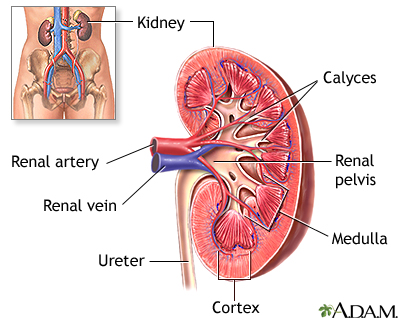Health Library
Rhabdomyolysis
Rhabdomyolysis is the breakdown of muscle tissue that leads to the release of muscle fiber contents into the blood. These substances are harmful to the kidney and often cause kidney damage.
Images

I Would Like to Learn About:
Causes
When muscle is damaged, a protein called myoglobin is released into the bloodstream. It is then filtered out of the body by the kidneys. Myoglobin breaks down into substances that can damage kidney cells.
Rhabdomyolysis may be caused by injury or any other condition that damages skeletal muscle.
Problems that may lead to this disease include:
- Trauma or crush injuries
- Use of drugs such as cocaine, amphetamines, statins, heroin, or PCP
- Genetic muscle diseases
- Extremes of body temperature
- Ischemia or death of muscle tissue
- Low phosphate levels
- Seizures or muscle tremors
- Severe exertion, such as marathon running or calisthenics
- Lengthy surgical procedures
- Severe dehydration
Symptoms
Symptoms may include:
- Dark, red, or cola-colored urine
- Decreased urine output
- General weakness
- Muscle stiffness or aching (myalgia)
- Muscle tenderness
- Weakness of the affected muscles
Other symptoms that may occur with this disease:
Exams and Tests
A physical exam will show tender or damaged skeletal muscles.
The following tests may be done:
- Creatine kinase (CK) level
- Serum calcium
- Serum myoglobin
- Serum potassium
- Urinalysis
- Urine myoglobin test
This disease may also affect the results of the following tests:
Treatment
You will need to get fluids containing bicarbonate to help prevent kidney damage. You may need to get fluids through a vein (IV). Some people may need kidney dialysis.
Your health care provider may prescribe medicines including diuretics and bicarbonate (if there is enough urine output).
Hyperkalemia and low blood calcium levels (hypocalcemia) should be treated right away. Kidney failure should also be treated.
Outlook (Prognosis)
The outcome depends on the amount of kidney damage. Acute kidney failure occurs in many people. Getting treated soon after rhabdomyolysis will reduce the risk of permanent kidney damage.
People with milder cases may return to their normal activities within a few weeks to a month. However, some people continue to have problems with fatigue and muscle pain.
Possible Complications
Complications may include:
- Acute tubular necrosis
- Acute renal failure
- Harmful chemical imbalances in the blood
- Shock (low blood pressure)
When to Contact a Medical Professional
Contact your provider if you have symptoms of rhabdomyolysis.
Prevention
Rhabdomyolysis can be avoided by:
- Drinking plenty of fluids after strenuous exercise.
- Removing extra clothes and immersing the body in cold water in case of heat stroke.
Related Information
Acute tubular necrosisAcute kidney failure
Necrosis
Shock
Arterial embolism
Deep vein thrombosis
Seizures
Toxicology screen
Heat intolerance
Heat emergencies
Alcohol use disorder
References
Haseley L, Jefferson JA. Pathophysiology and etiology of acute kidney injury. In: Feehally J, Floege J, Tonelli M, Johnson RJ, eds. Comprehensive Clinical Nephrology. 6th ed. Philadelphia, PA: Elsevier; 2019:chap 66.
O'Connor FG, Deuster PA. Rhabdomyolysis. In: Goldman L, Schafer AI, eds. Goldman-Cecil Medicine. 25th ed. Philadelphia, PA: Elsevier; 2020:chap 105.
Parekh R. Rhabdomyolysis. In: Walls RM, Hockberger RS, Gausche-Hill M, eds. Rosen's Emergency Medicine: Concepts and Clinical Practice. 9th ed. Philadelphia, PA: Elsevier; 2018:chap 119.
BACK TO TOPReview Date: 7/27/2021
Reviewed By: Walead Latif, MD, Nephrologist and Clinical Associate Professor, Rutgers Medical School, Newark, NJ. Review provided by VeriMed Healthcare Network. Also reviewed by David Zieve, MD, MHA, Medical Director, Brenda Conaway, Editorial Director, and the A.D.A.M. Editorial team.
 | A.D.A.M., Inc. is accredited by URAC, for Health Content Provider (www.urac.org). URAC's accreditation program is an independent audit to verify that A.D.A.M. follows rigorous standards of quality and accountability. A.D.A.M. is among the first to achieve this important distinction for online health information and services. Learn more about A.D.A.M.'s editorial policy, editorial process and privacy policy. A.D.A.M. is also a founding member of Hi-Ethics. This site complies with the HONcode standard for trustworthy health information: verify here. |
The information provided herein should not be used during any medical emergency or for the diagnosis or treatment of any medical condition. A licensed medical professional should be consulted for diagnosis and treatment of any and all medical conditions. Links to other sites are provided for information only -- they do not constitute endorsements of those other sites. © 1997- 2022 A.D.A.M., a business unit of Ebix, Inc. Any duplication or distribution of the information contained herein is strictly prohibited.
